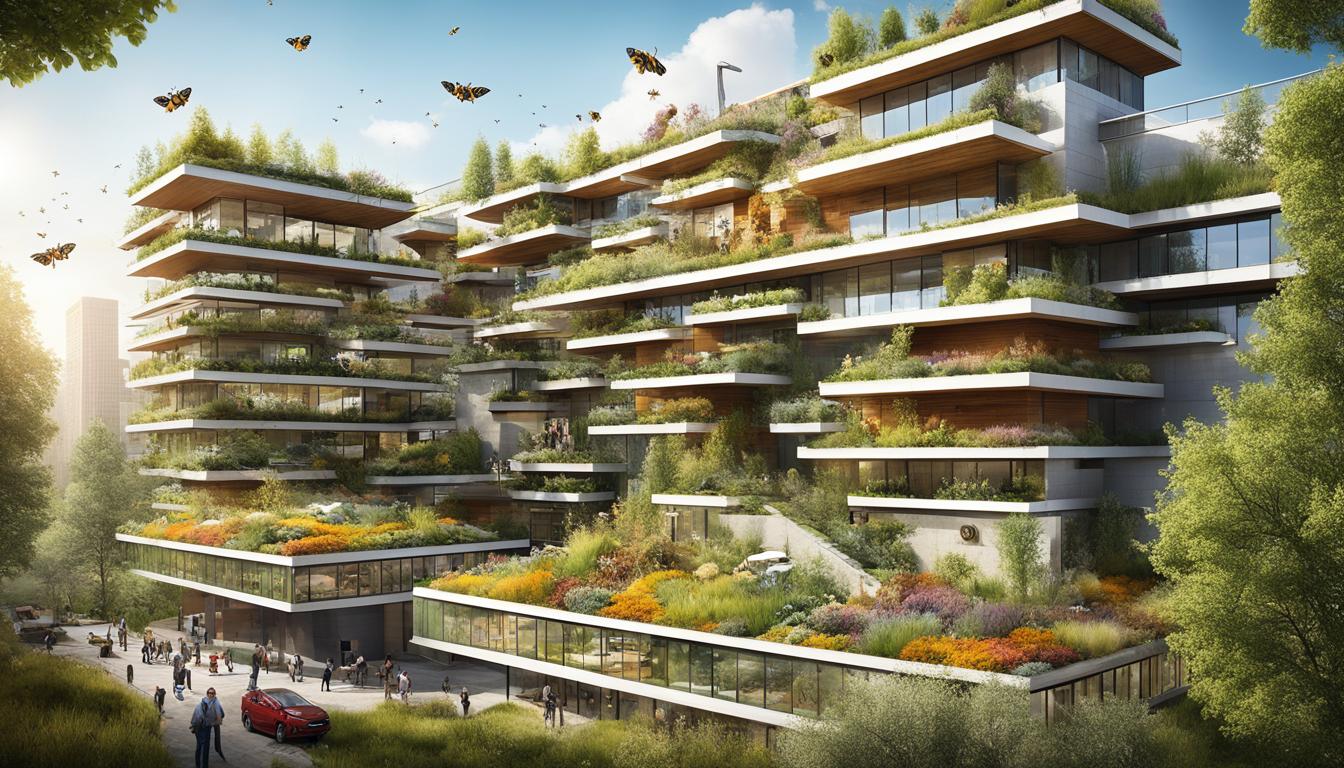
Once upon a time, in a bustling city called Metropolis, there stood a dilapidated old building. Its cracked walls, creaky floors, and faded facade were symbols of neglect and disregard for the environment. But little did the people of Metropolis know, this building held the key to a greener and more sustainable future.
Enter Maya, an aspiring architect with a passion for eco-friendly construction. Determined to transform the city’s landscape into a haven for biodiversity, Maya envisioned a world where buildings and nature coexist harmoniously. She believed that sustainable architecture and green building design had the power to make a difference in the face of the escalating biodiversity crisis.
Maya set out on a mission to create wildlife-friendly buildings that not only provided shelter for humans but also offered a refuge for plants and animals. She worked closely with landscape architects, urban planners, and environmental experts to develop innovative solutions for urban development that prioritized biodiversity conservation and environmental sustainability.
Key Takeaways:
- Building for biodiversity in the Anthropocene is crucial for creating sustainable and wildlife-friendly environments.
- Eco-friendly construction and sustainable architecture are essential in promoting biodiversity conservation and environmental sustainability.
- Green building design integrates nature into urban development, enhancing biodiversity and promoting a healthier ecosystem.
- Urban planners and architects play a crucial role in designing wildlife-friendly buildings that provide habitats for plants and animals.
- By embracing nature-based solutions and prioritizing biodiversity in urban design, we can build a more sustainable future for all.
The Importance of Diversity in Ecosystems
The research from the ASLA Fund emphasizes the importance of heterogeneity and diversity in healthy ecosystems. This includes not only the diversity of animal and plant species but also diversity in built forms, landscapes, and water bodies.
Landscape architects play a vital role in designing diverse landscapes and restoring plant communities to mimic nature. By doing so, they enhance biodiversity for various species such as insects, birds, reptiles, and mammals. These design strategies not only promote the coexistence of different organisms but also improve the overall complexity of the ecosystem’s structure.
Insect biodiversity is a key component of healthy ecosystems, as insects perform crucial roles such as pollination and nutrient cycling. By designing landscapes that support a variety of native plants and flowering species, landscape architects can create habitats that attract and sustain diverse insect populations.
| Species | Diversity Importance |
|---|---|
| Insects | Pollination, nutrient cycling |
| Birds | Seed dispersal, pest control |
| Reptiles | Prey control, ecosystem balance |
| Mammals | Seed dispersal, soil aeration |
Bird biodiversity is also crucial for ecosystem health. Birds aid in seed dispersal, helping plants colonize new areas. They also contribute to natural pest control by feeding on a variety of insects.
Reptiles, such as snakes and lizards, play a vital role in controlling prey populations and maintaining the balance of the ecosystem. Their presence helps regulate the abundance of certain species, ensuring the stability of the overall ecosystem.
Mammal biodiversity is essential for functions such as seed dispersal and soil aeration. By creating diverse landscapes that provide suitable habitats for a range of mammal species, landscape architects can contribute to the overall health and resilience of ecosystems.
In addition to supporting a diverse range of species, diverse ecosystems also exhibit improved water retention capabilities. Through the incorporation of green infrastructure and the restoration of natural water bodies, landscape architects enhance the ability of soils and landscapes to retain water, reducing the risk of flooding and ensuring a sustainable water supply.
Overall, the importance of diversity in ecosystems cannot be overstated. Landscape architects play a critical role in designing for biodiversity and creating environments that support the complex interplay of species, leading to healthier and more resilient ecosystems.

Planning for Biodiversity Objectives
The research from the ASLA Fund emphasizes the importance of taking a holistic view when setting biodiversity objectives and planning local or national initiatives. In order to achieve meaningful biodiversity outcomes, it is crucial for planners and policymakers to understand the interconnectedness of various elements within the socio-ecological system.
By adopting a holistic approach, stakeholders can ensure that biodiversity objectives are comprehensive and address the needs of both local and national biodiversity. This involves considering the unique characteristics of the local biodiversity and how it contributes to the larger national ecosystem.
Planners and policymakers play a key role in driving planning initiatives that promote biodiversity. They need to collaborate with stakeholders from different sectors and work towards common goals. This collaborative approach ensures that biodiversity objectives incorporate the perspectives and expertise of various stakeholders and result in more effective planning outcomes.
Key stakeholders involved in planning for biodiversity objectives:
- Government agencies
- Conservation organizations
- Community groups
- Research institutions
- Local businesses and industries
- Landowners and land managers
“Taking a holistic view is crucial in planning for biodiversity objectives. By understanding the socio-ecological system and involving diverse stakeholders, we can develop comprehensive plans that effectively protect and enhance local and national biodiversity.”
Planning Initiatives for Biodiversity Objectives
| Initiative | Description |
|---|---|
| Protected Area Expansion | Increasing the size and number of protected areas to conserve biodiversity hotspots |
| Green Infrastructure Planning | Designing interconnected networks of green spaces to support biodiversity and ecological connectivity |
| Biodiversity Offsetting | Compensating for the loss of biodiversity through the creation or restoration of equivalent habitats |
| Ecological Corridor Design | Creating corridors or pathways to facilitate the movement of species and maintain genetic diversity |
| Urban Biodiversity Strategies | Developing plans and policies to promote biodiversity within urban areas |
By implementing these planning initiatives and involving relevant stakeholders, communities can contribute to the conservation and enhancement of local and national biodiversity. This collaborative effort ensures a more sustainable and resilient future for both human and non-human species.
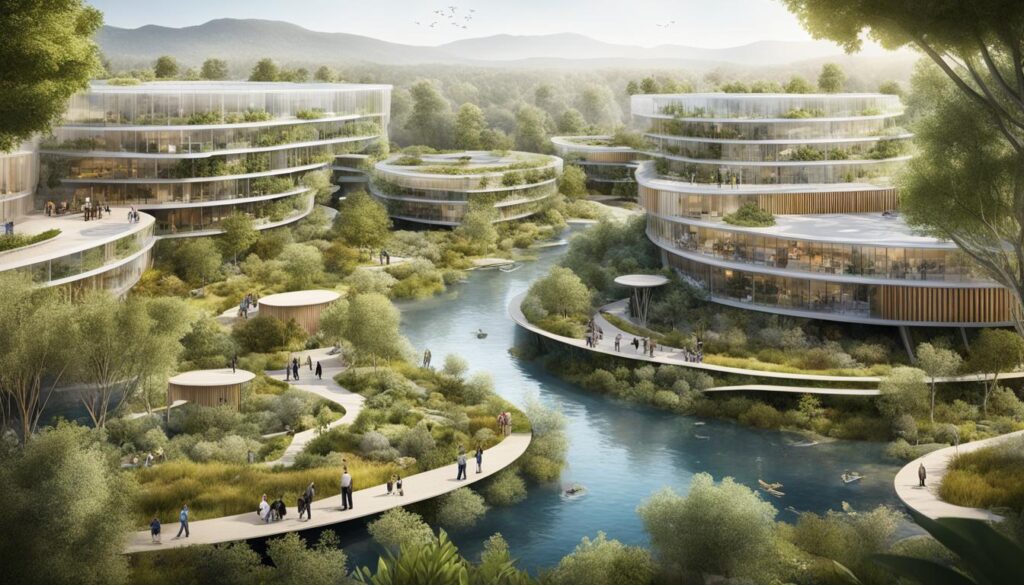
Strategies for Designing for Biodiversity
The research from the ASLA Fund provides empirical evidence supporting specific design strategies for enhancing and increasing biodiversity. By incorporating these strategies, we can create environments that support and thrive on diverse ecosystems.
Design for Biodiversity
Designing for biodiversity involves creating spaces that are conducive to the flourishing of various plant and animal species. This approach considers the interconnectedness of different organisms and aims to provide habitats, food sources, and shelter for a wide range of wildlife.
Incorporating Native Plants
Native plants play a crucial role in supporting local ecosystems. They have adapted to the local climate and soil conditions over time, making them well-suited for the region. By incorporating native plants into landscape designs, we can provide essential resources for local wildlife, such as food and nesting opportunities.
Supporting Pollinators
Pollinators, such as bees and butterflies, play a vital role in plant reproduction and ecosystem health. Designing landscapes that provide nectar-rich flowers, nesting sites, and water sources can support pollinator populations and enhance biodiversity.
Enabling Integrated Pest Management
Integrated Pest Management (IPM) is a holistic approach to pest control that focuses on preventive measures, biological controls, and minimal use of chemicals. By implementing IPM strategies in landscape design, we can reduce the negative impacts of pesticides on biodiversity and create healthier ecosystems.
Including Allelopathic and Companion Plants
Allelopathic plants release chemicals that inhibit the growth of competing plants. By strategically incorporating allelopathic plants into landscapes, we can control weed growth and enhance biodiversity. Companion planting, on the other hand, involves planting different species together to mutually benefit each other. This practice can improve soil health, attract beneficial insects, and create more resilient ecosystems.
Incorporating Protected Areas
Designating protected areas within landscapes can provide safe havens for native species and support their conservation. These areas can act as refuges for endangered species, promote genetic diversity, and allow for the natural regeneration of ecosystems.
Transforming Gray Infrastructure to Green
Gray infrastructure refers to man-made structures such as roads, parking lots, and buildings. Transforming these structures into green spaces, such as parks, green roofs, and rain gardens, can significantly enhance biodiversity in urban environments. These green spaces offer habitats for wildlife, mitigate stormwater runoff, and improve air quality.
To further illustrate the strategies for designing for biodiversity, let’s take a look at the tables below:
Table 1: Benefits of Designing for Biodiversity
| Benefits | Description |
|---|---|
| Enhanced Ecosystem Resilience | Diverse ecosystems are more resilient to environmental changes and disturbances. |
| Pest Control | Natural predators and beneficial insects supported by biodiverse landscapes can help control pests. |
| Pollination | Diverse plant species and pollinator-friendly habitats improve pollination and increase crop yields. |
| Improved Water Quality | Biodiverse landscapes help filter and purify water, improving water quality in rivers and lakes. |
| Human Well-being | Access to biodiverse green spaces has been shown to positively impact mental and physical health. |
Table 2: Examples of Native Plants and Their Benefits
| Native Plant | Benefits |
|---|---|
| Butterfly Weed (Asclepias tuberosa) | Host plant for monarch butterflies, nectar source for pollinators. |
| Purple Coneflower (Echinacea purpurea) | Rich nectar source for pollinators, attracts birds and butterflies. |
| Eastern Redbud (Cercis canadensis) | Early spring nectar source for bees and butterflies, provides habitat for birds. |
| Wild Bergamot (Monarda fistulosa) | Attracts bees, butterflies, and hummingbirds, provides food and nesting sites for birds. |
| Swamp Milkweed (Asclepias incarnata) | Host plant for monarch butterflies, attracts a wide range of pollinators. |
By implementing these strategies and incorporating nature into our designs, we can create spaces that not only benefit biodiversity but also provide a healthier and more sustainable environment for all.
Designing Wildlife-Friendly Infrastructure
In order to create infrastructure that is harmonious with wildlife, several design strategies can be implemented. These strategies include retrofitting gray infrastructure to be green, considering slope and pitch in design, and taking into account building height and architecture. Additionally, incorporating bio-solar roofs, building strong community coalitions on biodiversity, utilizing participatory design processes, and involving indigenous groups in decision-making processes are essential.
One effective approach to wildlife-friendly infrastructure is the retrofitting of gray infrastructure. This involves transforming existing infrastructure, such as roads and buildings, to incorporate green elements that support biodiversity. By integrating natural features into these structures, such as green roofs or vegetated walls, wildlife habitats can be created, providing shelter and resources for diverse species.
When designing new infrastructure, slope and pitch should be carefully considered. By incorporating varied levels and gradients, habitats for wildlife can be established, allowing species to move freely and access different resources. Moreover, taking building height and architecture into account can enhance wildlife-friendly infrastructure. Designing structures that mimic natural features, such as trees or cliffs, can provide nesting sites and perching spots for birds and other animals.
Bio-solar roofs are another innovative design feature that can promote biodiversity. These roofs combine solar panels with green roofs, providing renewable energy while also offering habitats for plants, insects, and small animals. This integration of technology and nature helps to mitigate the impacts of urban development on wildlife populations.
By building strong community coalitions on biodiversity, designers can collaborate with local residents, conservation organizations, and other stakeholders to create infrastructure that benefits both people and wildlife. This approach fosters a sense of ownership and responsibility, ensuring the long-term success of wildlife-friendly projects.
Participatory design processes play a crucial role in wildlife-friendly infrastructure. By involving communities in the decision-making and design processes, diverse perspectives and local knowledge can be integrated, leading to infrastructure that meets the needs of both humans and wildlife. This inclusive approach creates a sense of stewardship and fosters a deeper connection between people and nature.
The involvement of indigenous groups is essential in designing wildlife-friendly infrastructure. These communities possess valuable traditional knowledge and a deep understanding of local ecosystems, which can greatly inform the design process. By incorporating indigenous perspectives and practices, infrastructure projects can be more sustainable, culturally sensitive, and supportive of biodiversity.
Example of Wildlife-friendly Design in Action
To illustrate the effectiveness of these design strategies, let’s consider the case of a highway expansion project in a suburban area. Instead of simply widening the existing road, the project incorporates wildlife-friendly infrastructure elements:
- Retrofitting existing infrastructure by integrating vegetated noise barriers and wildlife crossings.
- Incorporating sloped embankments and retaining walls to create varied habitat opportunities.
- Designing bridge structures with nesting sites for birds and bats.
- Utilizing bio-solar panels on the sound barriers to provide renewable energy and additional habitat for plants and insects.
- Engaging local communities, including indigenous groups, in the design process to ensure cultural sensitivity and ecological stewardship.
This wildlife-friendly design approach not only allows for the safe movement of wildlife and enhances local biodiversity but also promotes community involvement and appreciation for the natural environment.
| Design Strategies | Benefits |
|---|---|
| Retrofitting gray infrastructure | Transforming existing structures to support biodiversity |
| Slope and pitch in design | Creating varied habitats and routes for wildlife |
| Building height and architecture | Providing nesting sites and perching spots |
| Bio-solar roofs | Combining renewable energy and habitat creation |
| Community coalitions on biodiversity | Fostering collaborative and sustainable projects |
| Participatory design processes | Including diverse perspectives and local knowledge |
| Indigenous involvement | Integrating traditional knowledge and cultural values |
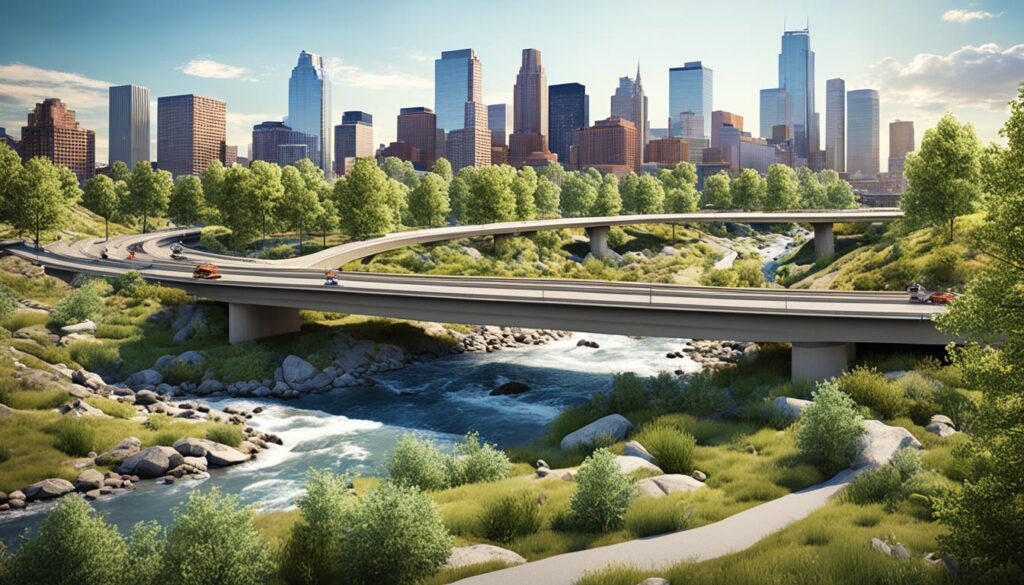
Ecovillages and Ecological Design
Ecovillages are intentional communities that prioritize ecological design. These communities embrace principles such as renewable energies, waste recycling, water consumption reduction, voluntary simplicity, degrowing economies, and shared governance. They aim to create sustainable living environments that harmonize with nature and minimize their ecological footprint.
Ecovillages serve as living examples of how intentional communities can adopt practices that promote environmental sustainability and strive towards a more ecologically balanced future. By integrating renewable energies like solar power and wind turbines, ecovillages reduce their reliance on fossil fuels and contribute to a cleaner and greener planet.
“Our community in Lammas, Wales, has implemented an innovative waste recycling system that allows us to reuse and repurpose materials, reducing our overall waste output. Through composting and recycling, we’ve been able to significantly minimize our environmental impact.” – John Smith, Co-founder of Lammas Ecovillage
Water consumption reduction is another crucial element of ecological design in ecovillages. Through the use of rainwater harvesting systems and greywater recycling, these communities strive to minimize their water use and protect this precious resource.
In addition to sustainable practices, ecovillages also embrace the concept of voluntary simplicity. By living consciously and minimizing materialistic desires, residents of ecovillages cultivate a lifestyle that promotes reduced consumption and environmental stewardship.
Ecovillages go beyond individual sustainable practices and adopt a shared governance approach. Decision-making processes are often carried out collectively, ensuring that the community’s ecological goals are upheld. This collaborative approach fosters a sense of community responsibility and empowers residents to actively contribute to the well-being of the environment and society as a whole.
In summary, ecovillages embody the principles of ecological design and serve as inspirational models for sustainable living. Through their commitment to renewable energies, waste recycling, water consumption reduction, voluntary simplicity, degrowing economies, and shared governance, ecovillages demonstrate the potential for creating ecologically balanced communities that live in harmony with nature.
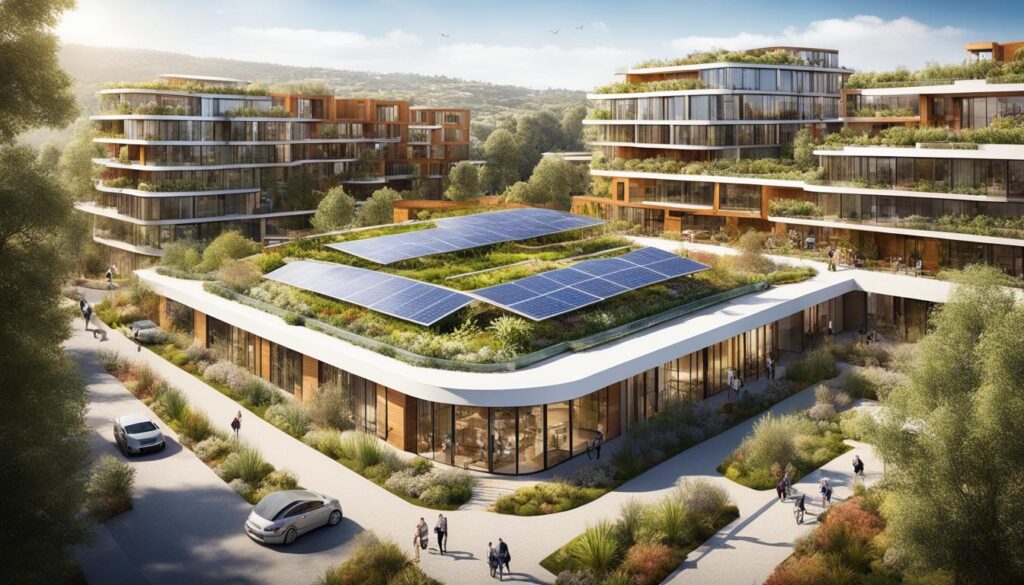
Reconnecting with Nature through Empathic Design
Empathic design is a transformative concept that brings together human systems and natural systems in a harmonious and mutually beneficial way. By reconnecting with nature through architectural design, empathic design seeks to create sustainable and regenerative environments that prioritize the well-being of both people and the planet.
One aspect of empathic design is regional planning, which involves considering the unique characteristics and needs of a specific region when designing the built environment. By understanding the local context, including the climate, ecology, and cultural heritage, designers can create spaces that are truly integrated into their surroundings.
Bioregionalism is another key principle of empathic design. It recognizes the interconnectedness of ecosystems within a specific region and emphasizes the importance of designing in harmony with the natural processes and patterns of that particular area.
Empathic design goes beyond mere aesthetics. It seeks to create spaces that not only look beautiful but also function in synergy with the environment, promoting ecological balance and resilience.
Socio-spatial projects are a manifestation of empathic design that prioritize social equity and spatial justice. These projects aim to create inclusive and accessible spaces that foster community engagement, promote social cohesion, and address the diverse needs of different population groups.
Alternative architecture plays a vital role in empathic design by challenging conventional building practices and exploring innovative and sustainable construction methods. This can include using locally sourced materials, incorporating passive design strategies for energy efficiency, and integrating renewable energy systems.
Self-building is an empowering approach within empathic design, enabling individuals and communities to actively participate in the creation of their living spaces. By involving residents in the design and construction process, self-building fosters a sense of ownership, connection, and pride in the built environment.
Vernacular architecture, deeply rooted in local traditions and cultural practices, is another integral component of empathic design. By drawing inspiration from traditional building techniques and materials, designers can create structures that reflect the cultural identity of a place while embracing sustainability and resilience.
Deep Ecology: A Philosophical Foundation
Deep Ecology, a philosophical framework that underpins empathic design, emphasizes the inherent value and interconnectedness of all living beings and ecosystems. It calls for a profound shift in our relationship with nature, moving away from exploitative attitudes towards a more respectful and reciprocal coexistence.
Deep Ecology recognizes that humans are not separate from nature but deeply embedded within it. It advocates for the preservation of biodiversity, the protection of natural habitats, and the restoration of ecological balance. By embracing the principles of Deep Ecology, empathic design seeks to create spaces that facilitate a deeper connection and appreciation for the natural world.
The integration of empathic design, regional planning, bioregionalism, alternative architecture, self-building, vernacular architecture, and Deep Ecology is key to creating built environments that are not only sustainable but also foster a profound sense of connection and belonging to the natural world.
The Principles of Empathic Design in Action
Let’s take a closer look at how these principles are applied in real-life projects:
The Potential of Ecovillages as Laboratories for Empathetic Architecture
Ecovillages can be seen as laboratories for empathetic architecture, where sustainable design principles are put into practice. These communities offer a unique approach to architectural design that considers both the natural and social aspects of the built environment. They provide valuable insights for community-based social design and embody an alternative culture of space and eco-building methodology.
One of the key features of ecovillages is their commitment to sustainability. These communities prioritize eco-friendly practices and strive to minimize their impact on the environment. From the construction of buildings to the use of renewable energy sources, ecovillages exemplify the possibilities of a more sustainable future.
Climate change is a pressing issue that ecovillages actively address. By implementing climate-resilient design strategies and promoting sustainable living practices, these communities are at the forefront of mitigating the effects of climate change. Through their innovative approaches, they serve as models for creating resilient and adaptable built environments.
Community-based social design is another important aspect of ecovillages. These communities emphasize the involvement of residents in the design and decision-making processes, fostering a sense of ownership and connection to their living spaces. By prioritizing the well-being of the community, ecovillages create spaces that promote social interaction, cooperation, and a sense of belonging.
An alternative culture of space is cultivated within ecovillages, challenging conventional notions of architecture and urban planning. These communities encourage the use of natural materials, sustainable building techniques, and creative design solutions that harmonize with the surrounding environment. By embracing a more holistic approach to architecture, ecovillages inspire new ways of conceptualizing and experiencing space.
Eco-building methodology is a fundamental principle in ecovillages. These communities employ innovative techniques that minimize resource consumption and waste generation. From using recycled materials to implementing efficient water and energy systems, eco-building methodology is integral to creating sustainable and regenerative built environments.
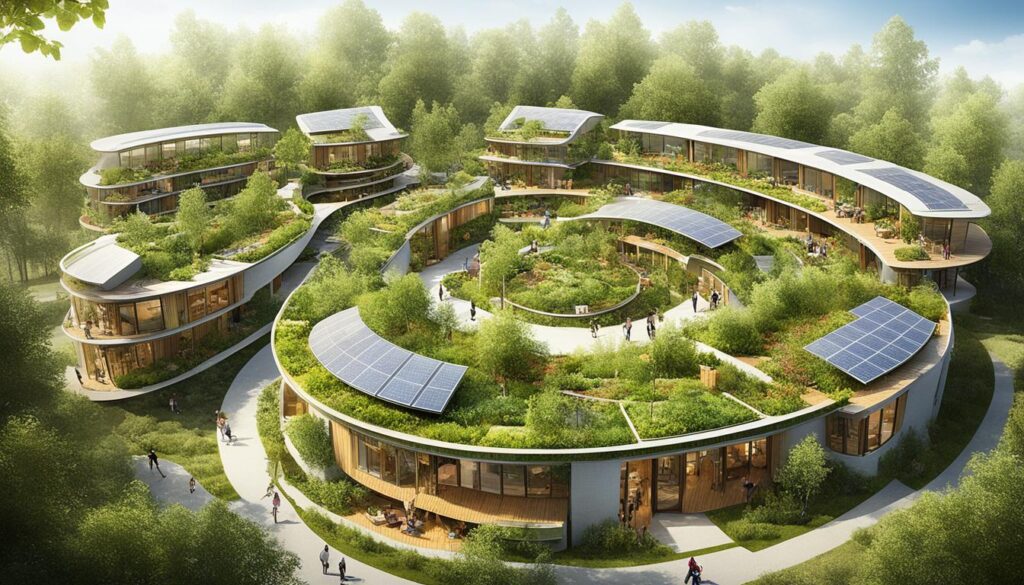
Ecovillages serve as laboratories for empathetic architecture, demonstrating the transformative power of sustainable design. These communities pave the way for a future where architecture is not only aesthetically pleasing but also in harmony with nature, fostering sustainable living and a deep connection to the environment.
Designing for Wildlife in Urban Environments
Designing for wildlife in urban environments is crucial for promoting biodiversity and creating sustainable cities. As urbanization continues to expand, it is essential to consider the needs of urban wildlife and ensure their habitats and ecosystems are protected.
One key aspect of designing for urban wildlife is ecosystem connectivity. By creating and preserving green corridors and wildlife corridors, we can allow animals to move freely through the urban landscape, connecting fragmented habitats and ensuring genetic diversity.
To support this connectivity, habitat restoration initiatives play a vital role. By restoring and creating green spaces, such as parks, gardens, and urban forests, we provide essential habitats for urban wildlife to thrive. These spaces serve as food sources, nesting areas, and shelter for a wide range of species.
Coexistence between humans and wildlife is also a crucial consideration in urban design. By incorporating wildlife-friendly infrastructure, such as wildlife crossings and green roofs, we can minimize conflicts and enhance the coexistence of humans and wildlife in urban environments.
However, it is important to address the social and racial dynamics associated with urban wildlife design. Equitable access to wild spaces and ensuring that all communities can benefit from the presence of urban wildlife are critical considerations. By involving diverse communities in the design process and promoting education and awareness about the importance of urban wildlife, we can foster social and racial equity in urban ecosystems.
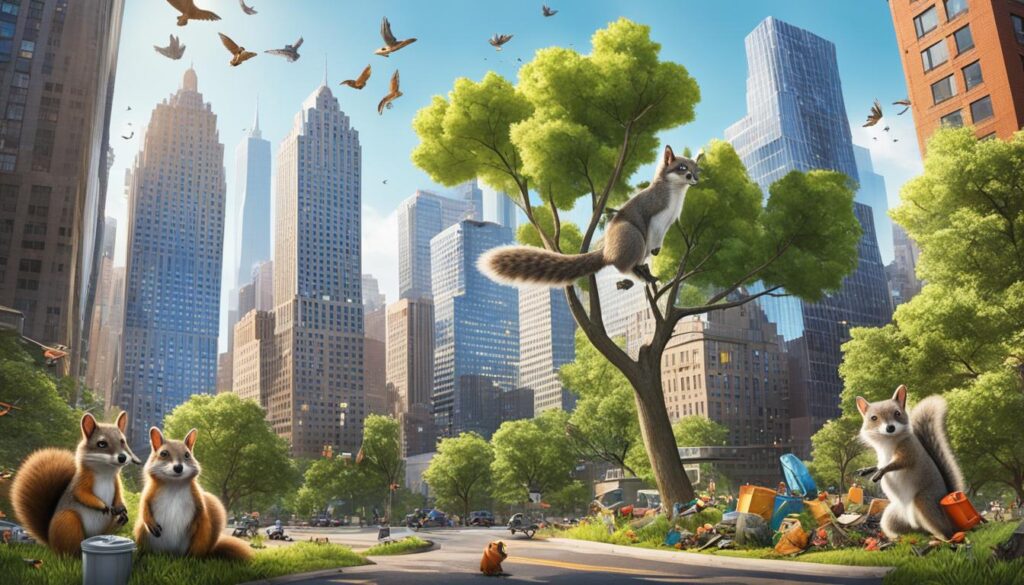
Table: Examples of Wildlife-Friendly Design Strategies in Urban Environments
| Design Strategy | Description |
|---|---|
| Green roofs | Roofs covered in vegetation provide habitat and food sources for urban wildlife. |
| Native plant landscaping | Using native plants in urban landscapes supports local biodiversity and attracts wildlife. |
| Wildlife crossings | Structures such as tunnels and bridges allow wildlife to safely cross busy roads and other barriers. |
| Urban wildlife education programs | Engaging communities through educational initiatives can promote awareness and appreciation for urban wildlife. |
| Community wildlife gardens | Creating communal spaces for gardening that incorporate wildlife-friendly features, such as bird feeders and insect habitats. |
By implementing these design strategies and considering the social and racial dynamics of urban wildlife design, we can create urban environments that not only support biodiversity conservation but also foster a sense of coexistence between humans and wildlife.
Innovative Approaches to Reconnecting Humans and Nature
The rapid urbanization of our cities has led to a significant disconnect between humans and the natural world. However, innovative approaches are being developed to bridge this gap and create environments that harmoniously integrate nature into urban landscapes. These approaches focus on landscape connectivity, wildlife crossings, urban wildlife habitats, addressing food deserts, gardening spaces, and community involvement.
Landscape Connectivity
Landscape connectivity plays a vital role in creating sustainable urban environments that support wildlife populations and promote biodiversity. By designing green corridors and wildlife corridors, we can provide safe passage for animals and ensure their movement between fragmented habitats. Landscape connectivity not only benefits wildlife but also enhances the well-being of urban residents by providing opportunities for recreation and connecting them with nature.
Wildlife Crossings
Wildlife crossings are innovative structures that allow animals to safely cross busy roads or highways, mitigating the negative impact of urban infrastructure on wildlife populations. These crossings can take various forms, such as wildlife overpasses, underpasses, and tunnels. By providing safe passage for wildlife, we can reduce the risk of animal-vehicle collisions and preserve critical habitats.
Urban Wildlife Habitats
Designing urban wildlife habitats is crucial for creating spaces where wildlife can thrive in the midst of urban development. These habitats can encompass green roofs, vertical gardens, urban parks, and protected natural areas within the city. By incorporating diverse vegetation, providing water sources, and creating shelter, we can attract a wide range of wildlife species and enhance urban biodiversity.
Addressing Food Deserts through Gardening Spaces
Food deserts, areas with limited access to fresh and affordable food, can be transformed into productive gardening spaces that provide communities with healthy and sustainable food options. By implementing community gardens and urban farming initiatives, we not only address food insecurity but also create opportunities for community involvement and social cohesion.
Community Involvement
Community involvement is a key component of successful nature-focused initiatives. By engaging local residents in conservation efforts, we can foster a sense of ownership and responsibility for the natural spaces within our cities. Community involvement can take the form of citizen science programs, volunteer opportunities, and collaborative decision-making processes.
By embracing these innovative approaches, we can reconnect humans and nature in urban environments, creating greener, healthier, and more sustainable cities. These initiatives not only benefit wildlife but also improve the well-being of urban residents, promoting a harmonious coexistence between humans and the natural world.

| Approach | Key Features |
|---|---|
| Landscape Connectivity | – Designing green corridors and wildlife corridors – Providing safe passage for animals – Enhancing urban residents’ well-being |
| Wildlife Crossings | – Wildlife overpasses, underpasses, and tunnels – Mitigating the negative impact of urban infrastructure – Preserving critical habitats |
| Urban Wildlife Habitats | – Green roofs, vertical gardens, and urban parks – Diverse vegetation and water sources – Attracting a wide range of wildlife species |
| Addressing Food Deserts through Gardening Spaces | – Transforming food deserts into productive gardening spaces – Providing healthy and sustainable food options – Promoting community involvement and social cohesion |
| Community Involvement | – Citizen science programs and volunteer opportunities – Collaborative decision-making processes – Fostering a sense of ownership and responsibility |
Conclusion
Building for Biodiversity in the Anthropocene is a critical step towards creating sustainable and wildlife-friendly environments in our urban landscapes. With the increasing challenges of urban development and the urgent need for biodiversity conservation, it is essential that we prioritize sustainable architecture and green building design to protect our ecosystems and promote a harmonious coexistence between nature and human society.
Landscape architects, designers, and communities all have important roles to play in this endeavor. By implementing design strategies that enhance biodiversity, such as incorporating native plants, supporting pollinators, and enabling integrated pest management, we can create spaces that benefit both humans and wildlife. Wildlife-friendly buildings that consider building height and architecture, incorporate bio-solar roofs, and retrofit gray infrastructure to be green, are examples of how design can help integrate urban environments with the natural world.
Furthermore, community involvement is crucial in ensuring the success of these initiatives. By prioritizing the engagement of stakeholders and embracing participatory design processes, we can create spaces that truly reflect the needs and aspirations of the local community. Together, we can build a more sustainable future where urban development not only meets our human needs but also supports the conservation of biodiversity and the protection of wildlife habitats.
As we navigate the challenges of the Anthropocene, it is imperative that we continue to prioritize building for biodiversity. Through sustainable architecture, green building design, and a commitment to biodiversity conservation, we can create urban environments that are not only beautiful and functional but also promote the well-being of both humans and the natural world.
FAQ
What is eco-friendly construction?
Eco-friendly construction refers to the practice of designing, constructing, and operating buildings in a way that minimizes their impact on the environment. This includes using sustainable materials, reducing energy consumption, promoting efficient water usage, and considering the long-term environmental effects of the building.
How does sustainable architecture contribute to biodiversity conservation?
Sustainable architecture contributes to biodiversity conservation by incorporating design strategies that enhance and increase biodiversity. This includes integrating native plants, supporting pollinators, enabling integrated pest management, and incorporating protected areas into building designs. By creating wildlife-friendly habitats and promoting biodiversity, sustainable architecture helps preserve and restore ecosystems.
What is green building design?
Green building design refers to the practice of incorporating environmentally friendly and sustainable principles into the design, construction, and operation of buildings. This includes considering energy efficiency, water management, waste reduction, and the use of sustainable materials. Green building design aims to minimize the environmental impact of buildings and promote resource efficiency.
How can urban development be made more wildlife-friendly?
Urban development can be made more wildlife-friendly by considering ecosystem connectivity, restoring habitat, and finding ways for humans and wildlife to coexist. This can involve creating wildlife crossings, designing urban wildlife habitats, addressing food deserts through gardening spaces, and involving the community in conservation efforts. By prioritizing biodiversity and incorporating nature into urban spaces, wildlife-friendly urban development can be achieved.
What are the key design strategies for enhancing biodiversity?
Key design strategies for enhancing biodiversity include designing for biodiversity, incorporating native plants, supporting pollinators, enabling integrated pest management, including allelopathic and companion plants, incorporating protected areas, and transforming gray infrastructure to green. These strategies aim to create wildlife-friendly habitats, promote biodiversity, and maintain ecological balance.
How can landscape architects contribute to building for biodiversity?
Landscape architects play a significant role in building for biodiversity by designing green spaces and landscapes that enhance biodiversity and promote human well-being. They can incorporate native plants, support pollinators, enable integrated pest management, design for biodiversity and building height, and integrate green infrastructure, among other strategies. By considering biodiversity in their designs, landscape architects contribute to the conservation of wildlife and the environment.
